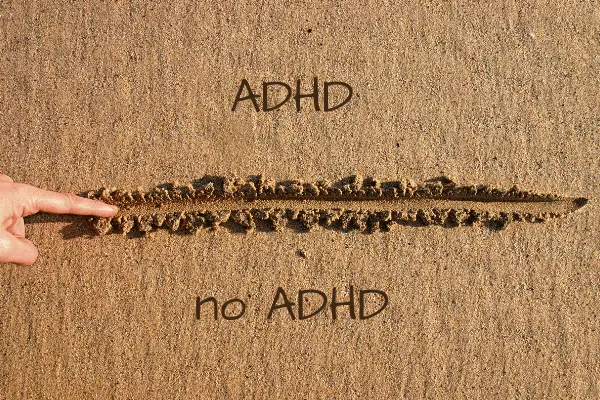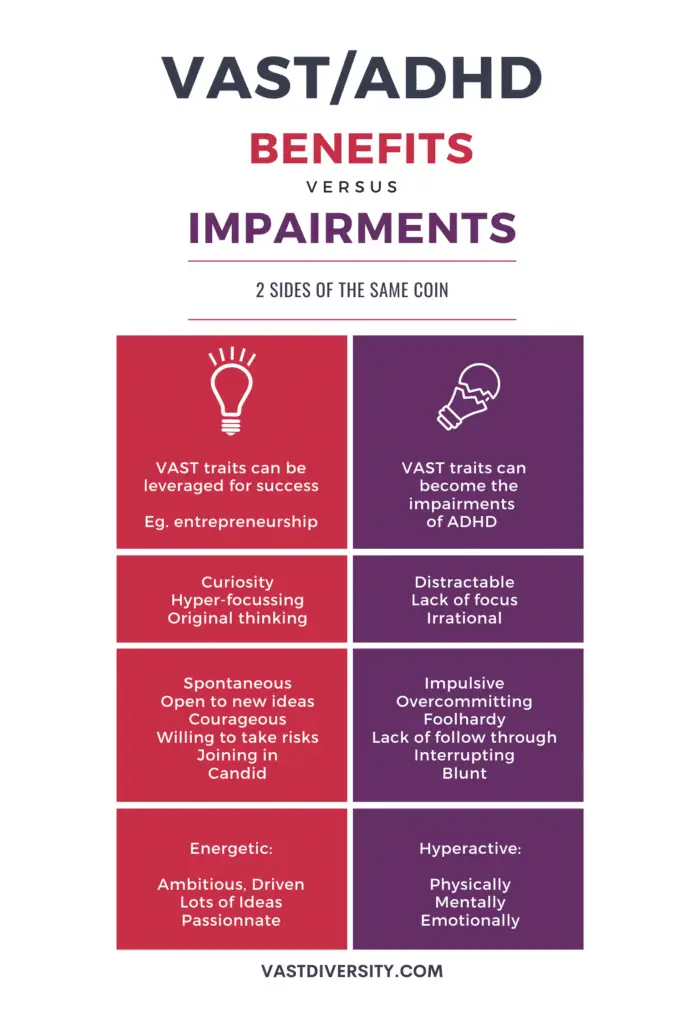- Do you dive into projects you are passionate about?
- Can you have trouble getting started, unless the deadline is close?
- Are you mystified by people who are happy with a boring 9-5 job, even if it pays really well?
- Do you consider yourself a deep thinker?
- Are you really persistent?
- Are you a creative problem solver?
- Do you wish people would just get to the point and hate small talk?
- Does your curiosity lead you to research something intensely?
- Are you a night owl?
- Are you more sentimental or moved by beauty than other people?
- Would a beach vacation bore you because you’d prefer to explore?
- Do you often misplace your keys and other items?
- Do you have a quirky sense of humour?
- Are you a loyal friend?
- Do you value honesty highly and detest hypocrisy?
If you answered YES to several questions, you may have a VAST mind or VAST personality.
What is VAST (Variable Attention Stimulus Trait)?
VAST stands for Variable Attention Stimulus Trait, and is a new term introduced by Drs. Hallowell and Ratey in their latest book ADHD 2.0. Variable Attention Stimulus Trait describes all people with ‘ADHD’ traits even if not meeting the full criteria for an ADHD diagnosis.
Drs. Hallowell and Ratey have ADHD themselves and realize that the complexities of ADHD (Attention Deficit Hyperactivity Disorder) have been minimized and misunderstood. Their experience with people who have VAST or ADHD includes some extremely successful people.
Variable Attention Stimulus Trait is a new term to describe this type of brain more clearly. VAST and ADHD is not about a deficit of attention, it is about a variability of attention.
Who has VAST (Variable Attention Stimulus Trait)?
Anyone can have a VAST brain and it is not related to intelligence. People who have Variable Attention Stimulus Trait include: Pulitzer prize winners, Nobel prize winners, billionaires, doctors, lawyers, actors, trendsetters, entrepreneurs, inventors….. and many others.

Having Variable Attention Stimulus Trait means that you have a brain with unique wiring that can lead to creative thinking, adventurousness, courage, integrity, perseverance and a desire to make a change.
It is estimated that about 10% of the population has Variable Attention Stimulus Trait. If you don’t have a VAST mind yourself, you definitely know and admire someone who does.
Variable Attention Stimulus Trait: A New Name for ADHD
So you might wonder: Who cares about what letters we use to describe this type of brain? Why do we need a new name?
What’s in a name? That which we call a rose by any other name would smell as sweet.
William Shakespeare
No offence Shakespeare, but there are many reasons, because the way we think about ADHD is totally wrong.
Variable Attention Stimulus Trait is a more accurate term, as ADHD (Attention Deficit Hyperactivity Disorder) actually has nothing to do with a deficit of attention.
Trust me, we can focus on what interests us. ADHD or VAST is having a variability of attention based on how stimulated our brains are.

Reasons For The New Term VAST (Variable Attention Stimulus Trait)
- This term more clearly explains the ADHD mind’s variability of attention or focus.
- VAST/ADHD traits exist on a continuum and this can change with life circumstances.
- Many people have ‘ADHD traits’ but don’t meet the strict criteria for ADHD diagnosis.
- Adults can have VAST/ADHD, it is not just about children.
- Highly intelligent people can have VAST/ADHD brains.
- VAST is actually symbolic of ADHD brain. We have VAST ideas, emotions and personalities.
- Understanding you have a VAST mind can be life changing.

VAST/ADHD is a Result of Different Brain Wiring
Although each VAST mind is unique, they are wired in a way that affects how our minds deal with stimulation and attention. VAST minds are considered neuroatypical and are highly genetic.
This means that if you have a VAST mind you were born with it, and likely come from a family with other VAST minds. (Brains can develop VAST traits from our fast paced culture and stress, but I will for now focus on those with VAST minds from birth.)

The atypical wiring in the VAST brain results in a difference in how our brains respond to neurotransmitters such as dopamine and norepinephrine.
This results in a ‘variable response to stimuli’. Translation: we can be very passionate, focused and persistent when we are interested, but procrastinate or get easily distracted when we are bored.
VAST/ADHD Brain is a Continuum
While you are born with a VAST (Variable Attention Stimulus Trait) mind, it exists on a continuum, with ADHD (Attention Deficit Hyperactivity Disorder) at one end.
To be diagnosed with ADHD requires having impairments from specific symptoms (distractability, and hyperactivity/impulsivity).
Make no mistake, severe untreated ADHD can be debilitating, resulting in a poorer quality of life and even a risk of an early death. The amazing thing is that the treatment options for ADHD are among the most successful and life altering in all of medicine, a credit to medicine and medical research.

But the problem is that the medical model of ADHD only focuses on impairment and is very limiting.
First of all, it draws a line in the sand. Either you have ADHD, or you do not have ADHD.

What about people who have ‘ADHD traits’ but do not fully meet the criteria of impairment?
What about the fact that VAST/ADHD traits can vary based on life circumstances, like stress, and hormone changes?
By not understanding the fact that VAST/ADHD traits exist on a continuum that can change, we are leaving people with VAST vulnerable to becoming impaired.
VAST vs ADHD, Looking at ADHD Strengths
No one goes to their doctor and says:
’Hey, I think I’m more creative and driven than the average person, should we do some tests?’
No, we go see to our doctor when there is a problem, so medicine and the diagnostic criteria focus on impairments, not positive traits.
You might think ‘What? Positive traits of ADHD? Distractibility, hyperactivity and impulsivity? You consider these positive traits?’
Yes, actually, if leveraged properly they can be! Many successful people credit their ADHD traits for their success!
ADHD has been called the ‘explorer gene’ or the ‘entrepreneur trait‘.

Distractibility can also mean noticing things others do not.
Hyperactivity can give someone the drive to succeed.
Impulsivity done right is called spontaneity.
All the traits together can lead to innovation and creative problem solving, among other things.
JetBlue founder David Neeleman famously credits his ADHD for his success:
“I can distill complicated facts and come up with simple solutions. I can look out on an industry with all kinds of problems and say, ‘How can I do this better?’ My ADD brain naturally searches for better ways of doing things.”
David Neeleman
ADHD vs VAST: Advantages of ADHD
So let’s get a more expansive view of VAST/ADHD. One study looked at the positive traits in a group of successful adults with ADHD.

The researchers found these adults with ADHD had key traits:
- Cognitive Dynamism (Divergent Thinking, Hyperfocus, Creativity, Curiosity)
- Courage (Non-Conformist, Adventurousness, Bravery, Integrity, Persistence)
- Energy (Spirit, Psychological, Physical)
- Humanity (Social Intelligence, Humour, Self-Acceptance, Recognition of Feelings)
- Resilience (Self-Regulation, Sublimation)
- Trancendence (Appreciation of Beauty and Excellence)
Creativity, divergent thinking, bravery, persistance, integrity, energy, appreciation of excellence…. these are not deficits.
This is a list of traits seen in entrepreneurs, explorers, inventors, and people fighting for social change. This is a list of traits that can and has changed our world!

VAST vs ADHD, Benefits vs Impairments
VAST/ADHD traits can be benefits, but also impairments. It is really just two sides of the same coin.
Variable Attention Stimulus Traits can be leveraged for success, or can become the impairments of ADHD.

You could be known for your curiosity, original ideas and the ability to hyper-focus.

Or you could be a person who is easily distracted, with lack of focus and even be irrational at times. (Read more about ADHD ‘Object Permanence’ issues for another take on how our brains work.)
You could be a very spontaneous person, open to new ideas, courageous and willing to take risks.

Or you could be impulsive, overcommitting yourself and be considered foolhardy with a lack of follow through.
You can be known to enthusiastically join in and share your candid viewpoint.

Or you could be considered someone who insults people by interrupting and being too blunt.
You could be considered a very energetic person, known for your ambition and drive, with lots of ideas and passion.

Or you could be considered physically hyperactive, a person with scattered ideas who seems overly emotional.
These really are just two sides of the same traits.
Making the Most of the VAST/ADHD Mind
So looking at how these traits can become benefits and/or impairments, how do we leverage these traits?
By understanding them and finding the sweet spot that leads to success.
Real life examples of harnessing distractibility, impulsivity and emotional excitability into the positive attributes like creativity, energy, humanity, resilience and persistance were found in a study of ADHD entrepreneurs.
The successful ADHD entrepreneurs cultivated a passion for developing and founding, with a reduced focus on inventing.
This means that after you come up with your great idea, you need to persevere to develop it into a successful product, like Focus@Will ADHD entrepreneur Will Hanshell.
Because VAST minds are vulnerable to losing focus and getting overstimulated by constantly thinking of a new idea or how to solve more problems. This leads to a greater risk of burnout. (These Huberman Lab approved brain health supplements may help with burnout resilience)
Harnessing the Powerful VAST/ADHD Brain
Dr. Hallowell describes the VAST/ADHD brain as having ‘a Ferrari engine but with bicycle-strength brakes’.
Realizing you have VAST mind is the first step to strengthening your ‘brakes‘ so you harness these VAST traits to achieve your goals.

The VAST mind ability to hyperfocus can become a superpower when harnessed. There are lots of tips and tricks to increase productivity.
Knowing you have a VAST/ADHD brain is important as it can react differently to stress, hormones and certain medications. VAST/ADHD might make you more likely to have certain habits like body focused repetitive behaviors like skin or scalp picking or cheek biting. It might be linked to other traits like a bent pinky finger, or having cold hands.
Amazingly, certain exercises, meditation and other techniques like Non-Sleep Deep Rest protocols to optimize brain function (Yoga Nidra and self-hypnosis) may work better on our brains! So there are a ton of options to pave the way to success.
If you are wondering if you have VAST or ADHD, here are some medically validated assessment tools for adult ADHD.
References
- Delivered from Distraction, Hallowell and Ratey, 2017
- ADHD 2.0, Hallowell and Ratey, 2020
- VAST discussed in Dr. Hallowell’s Distraction podcast
- Emotion dysregulation in adults with attention deficit hyperactivity disorder: a meta-analysis, Similarities between emotional dysregulation in adults suffering from ADHD and bipolar patients
- Current and emerging pharmacotherapy for the treatment of adult attention deficit hyperactivity disorder (ADHD),
- Creativity in ADHD: Goal-Directed Motivation and Domain Specificity
- The positive aspects of attention deficit hyperactivity disorder:a qualitative investigation of successful adults with ADHD
- ADHD symptoms, entrepreneurial passion, and entrepreneurial performance
